#News for Hendon London
Explore tagged Tumblr posts
Text
#hendon mincabs london#hendon london#London#UK#United Kingdom#News#Marketing#Hendon News#News for Hendon London#Tumblr#Tumblr Trending
0 notes
Text
The father of two from Hendon recounted the harrowing ordeal to Jewish News. “We left the game early to meet a friend. As we walked towards the bar area, chaos broke out—mopeds appeared from alleyways and a crowd surrounded an Israeli man.”
He described the horrifying scene: “The man was on the ground, his head pinned between a kerb and a metal gate, being viciously kicked.”
Aaron and his friend Jacob intervened, managing to push the attackers away and help the victim. “We thought it was over,” he said. But moments later, the gang returned and confronted them, asking, “Are you Yehudi? Are you Jewish?”
Jacob, a father of three from Golders Green, said the thugs asked to see their passports to check whether they were Jewish.
Despite denying they were Israeli and pleading to be left alone, the gang continued their intimidation, grabbing Aaron’s friend’s coat before the situation escalated further.
“I told him to leave him alone, and the next thing I know he punched me in the face. It was so unexpected. My glasses were broken, my nose split. Blood everywhere. After he punched me, about 20 more came out of their hiding places to effectively finish me off. But I stood my ground. I said what you’re doing is why you’re not getting any support.”
When the leader of the gang said: “He’s British, leave him alone”, another responded “Yes, but he helped a Jew.”
“That,” says Aaron, “is why they were angry. Because I helped a Jew.”
20 notes
·
View notes
Text
The Bill - Series 1
This should have been a 12-episode series, however it was cut short to 11 by the industrial dispute between Thames and a technicians' union meaning only 11 were completed by the time it went to air. The final 12th episode was rewritten to become the final episode of series 2 instead (The Chief Supers Party)
The strike led to an alteration in the order of the series airing for everywhere in the UK that wasn't London. In the London 'Thames' offices, members of the management aired episodes 2 and 3 (A Friend In Need and Clutching At Straws) in their usual timeslot themselves after the technicians had walked out. However at the other ITV companies (Tyne Tees/Yorkshire etc), the technicians refused to play any Thames Television programmes so episodes 2 and 3 aired at the end of the series after The Sweet Smell Of Failure.
The 'station' was a former cigarette packing warehouse in Wapping on the corner of Pennington St (the cobbles in the credits) and Artichoke Hill. It was so small that the offices doubled as production offices. Using an actual building to film in; although rare in the 80s; rather than a set allowed a feel of realism because the cameras could follow actors out of the station and onto the street.
Karen England and Paul Page Hansen are the credits 'walking feet'. They appear as extras in the first series.
Jon Iles (Dashwood) and Tony Scannell (Roach) were only supposed to be in 2 episodes. The actors were so well-liked on set that they remained.
Larry Dann was only given the job as Peters the day before filming of series 1 began because the original actor kept forgetting his lines.
Robert Pugh refused to commit to a series so Galloway was recast and John Salthouse joined the cast.
Peter Ellis originally auditioned to be in CID but it was thought that he was too old. However, TPTB wanted to keep him on board so they cast him as Superintendent Brownlow.
Peter Dean's character, Sgt Wilding, was changed to Eric Richard's character, Sgt Cryer. In the time between the pilot and the series, Dean had joined EastEnders and couldn't commit to The Bill.
Taffy undergoes a complete name change from Dai Morgan to Francis Edwards. In Woodentop he gives his first name as 'Dai' which is Dafydd or David.
I know it's the 80's but it's jarring just how many are smoking and the amount of moustaches - and that's just the women!
They're still known as Uniform Oscar as they were in Woodentop.
Chris Ellison appears in 3 episodes (one this series and two the next) as 'Tommy Burnside' rather than his identical twin brother (!!) Frank as he becomes. Tommy is nothing like Frank, he's more a weedy pain in the arse.
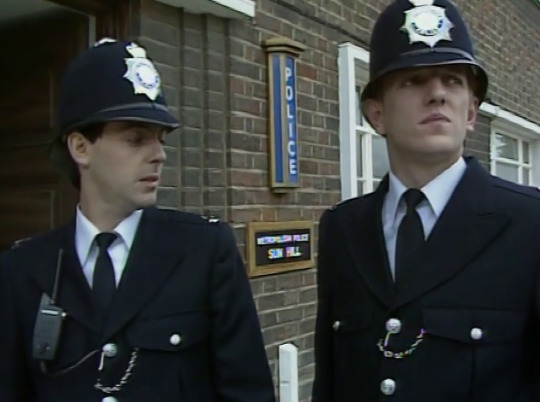
Funny Old Business: Cops And Robbers
Sgt Bob Cryer arrives at work at 6.25am to find a prisoner being loaded into an ambulance after an epileptic fit. Right from the off Bob is shown as warm and well respected. He greets everyone the same, be it CID officers or the cleaner or a secretary (both of whom he says hello to by name). Sgt Alec Peters explains that the station doctor passed the man off as drunk only when he was brought in by Reg and 'PC Burton'. The doctor could be in quite some hot water...
Jim is clearly more at ease now, however, it's not stated in canon how long has passed since Woodentop. Best guesstimates are approximately 1 to 2 months given Woodentop mentioned school holidays would start soon in the briefing and Bob says that the kids are about to return to school. Both Dave and June bring up the youth that Jim clipped round the ear, Viv calls him 'The New Boy', Jim still refers to Hendon exercises as his experience of riots and rough arrests and he is classed as a new face at a cafe uniform frequent when on the beat. Having said all this, Jim makes his first arrest in this episode so it may be even less time!
Jim and June sort of flirt over how much sugar Jim has in his tea. He's a thoroughbred don't you know 😉. Taffy tells JimJim that he reckons June rather fancies him. Jim is not impressed and tells Taffy off for being crude. He insists he doesn't fancy June, that she's still getting over being messed around by Dave and he'd never get involved with anyone from the job. (*cough*)
The series starts to set Taffy up as a bit of a grump from episode 1, a far cry from the "Cheeky Leeky" he was in Woodentop. He has good reason here though as the National Front has been given the go-ahead to march through Sun Hill which means all leave has now been cancelled until further notice. It was due to be June's first weekend off in months so she's doubly unimpressed at JimJim's reasoning that it's the price of democracy. Things have not improved at all between Dave and June. There is however another female PC (not just the unnamed extra Alec 'coorrrrr'ed' at) as Viv has arrived!
Roy has learned from his mistakes from Woodentop and is attending a uniform briefing. He finds it absolutely riveting.
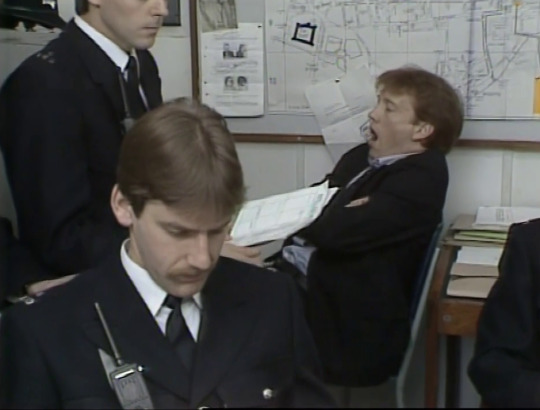
Roy tells uniform to keep an eye out for properties with new double glazing as CID believes they're being targeted in burglaries. He warns them not to touch anything but to remain on scene until CID arrives if they come across one. Bob and Roy have more of a jovial frenemy relationship than Jack and the old Roy did.
"Sometimes Roy, only sometimes, you can be almost human!" Bob is amused when he takes a burglary to Roy that matches the MO that he'd asked uniform to look out for. Roy actually thanks him - now there's a first! Reg takes a man through to see Roy. Later Reg complains to June that Bob is a nosy old git - oh the irony! 😂 "A good Sgt knows everything that goes on in his nick."
Three months of work are paying off for Roy - a team of the same lads from the same company carried out work replacing the windows and doors of a large number of recently burgled properties. The firms managing director tells Roy that the keys are taped to the new doors to avoid getting mixed up - they could easily be taken and made copies of and it would explain why there are no other signs of entry. They wait 4-6 months and then return to the property, letting themselves in by the front door.
Uncle Bob is not too happy to find Jim Jim and Taffy having a water fight in the men's loos after a messy arrest. "Bleedin' Woodentops." he sighs as he watches them go.
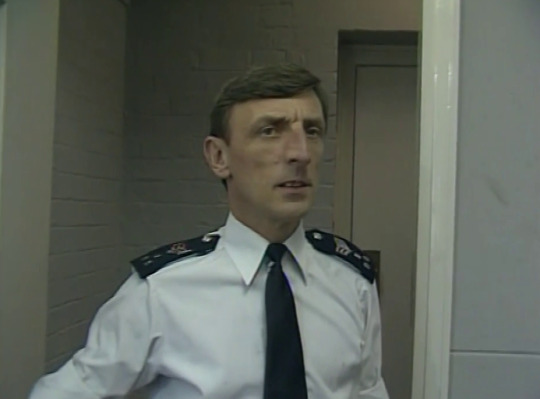
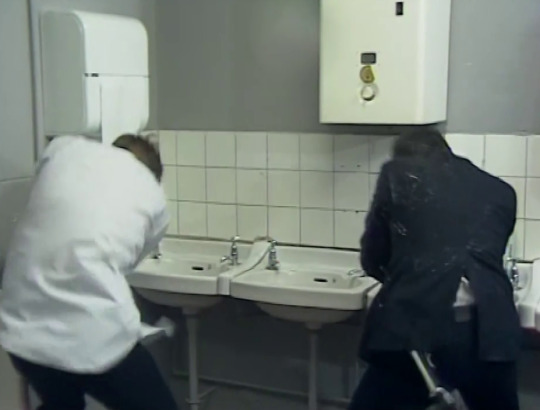
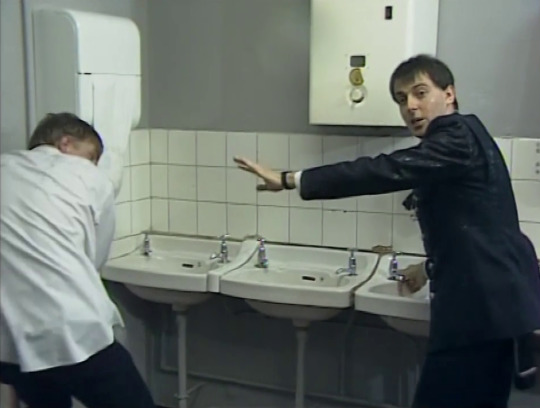
June claims Bob won't let her and Viv patrol when the National Front are marching through Sun Hill, claiming that he's such an old mother hen sometimes (again - the irony!). Viv asks her what she thinks of Jim. She reckons he's a bit tasty but they're interrupted by a man reporting that he'd had his pockets picked before June can reply.
Dave is guarding the door of the burgled house, waiting for Roy to arrive. There's a kid who keeps asking them what they're doing. At first they ignore him but Dave tells him in such a quiet and indirect way that he's 'looking for fingerprints' it does make you wonder whether he's just a local kid they allowed to watch 😂 Especially when Roy literally lifts the kid up and moves him aside and they all ignore him for the rest of the scene.
DS Tommy Burnside appears for the first of his three appearances before he becomes DI Frank Burnside in series 4. There's no love lost at all between Tommy and Bob. Tommy insists he'll wait for Roy to return. Unfortunately, Jim's first arrest is a snout of Tommy's and he wants Roy to let him off. Bob tells him it's too late - he's already been nicked and charged. "That's what I like to see, Bob. Co-operation." "Bloody Superstars!"
Roy tells Tommy it's too late as his snout is already in the system. Tommy bluffs that his governor - an old acquaintance of Roy's - won't be happy. Roy pulls him up on it immediately and throws him out of the office. Tommy begs him for a favour and even says please. He explains he's due a result from the snout and the arrest compromises it. He promises they can have him back within a few days. Roy allows him to be released as long as he remains Sun Hill's body. He talks Bob into bailing him for a couple of days because 'he owes him one as does Jim. (In Woodentop this was Jack Wilding rather than Bob who wasn't in the episode). He tells him to bail him whilst 'inquiries are made about the property found in his possession'. "You've got all the answers."
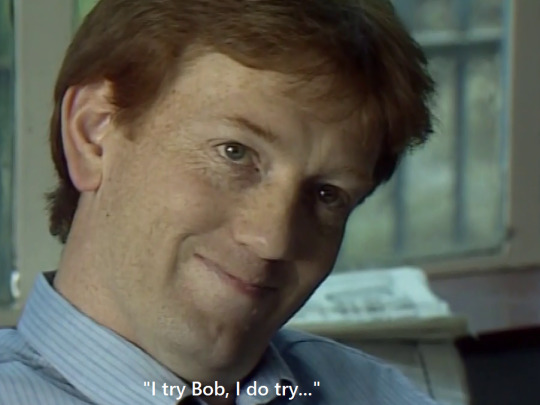
Uniform have been trying to catch a group of pickpocketers for quite some time and so far remain unlucky. Bob and Tom are shocked when a well-to-do man arrives having made a citizens arrest of another man who has badly bleeding fingers. The doctor is called for and it transpires that the prisoner from that morning has passed. The well-to-do man accuses the other of picking his pocket and shows the officers some fish hooks sewn into the lining of his jacket that the man had snagged his fingers on, making them bleed profusely.
Charles and the doctor are old friends and he tries to reassure him that it wasn't his fault. He tells the doctor that a few years ago a woman died because of his actions - or rather his inaction. He reminds him that they are human and that everyone makes mistakes and they just have to find a way to live with it. From what he understands 99% of doctors would have made the same diagnosis with the evidence at hand. The doctor blames himself, claiming it's unforgivable as he classifies it as outright neglect.
Outside in the car, Tommy shows more of a Frank reaction to his snout after he'd had to grovel and eat humble pie to get him bailed. The snout snivels that it won't happen again and is scared of him. What makes it worse for Tommy is that his snout was caught by "A bleedin' Woodentop who's still on probation!", telling him that it'd make him about as useful to him as a one-legged man in an arse-kicking contest." As they drive by Jim and Taffy, the snout sticks his fingers up at Jim, little knowing he'll be returned to Sun Hill by Tommy to be charged in a couple of days.
#funny old business cops and robbers#the bill#peter ellis#charles brownlow#eric richard#bob cryer#mark wingett#jim carver#nula conwell#viv martella#june ackland#trudie goodwin#reg hollis#jeff stewart#dave litten#gary olsen#tommy burnside#chris ellison#burnside#roy galloway#john salthouse#taffy edwards#colin blumenau#larry dann#alec peters#tom penny#roger leach#series 1#01x01#robin frank
2 notes
·
View notes
Text
'Uh, To Steve Wright … Burn In Hell - FOREVER!' (Hang The DJ! Hang The DJ! Hang The DJ!)
Every Toy Dolls fan in the world has long waited for this day.

We don't forgive, and we don't forget.
Steve Wright was an atypical ultra-prick who believed if you weren't wearing the latest fashions and poodle haircuts you shouldn't be even allowed outside. Toadying to rich 'artists' and rich record labels, whilst using his platform on BBC Radio One (paid for by the general public via taxation) to sneer at every independent act on the block.
Lampooned by Viz Comic in Steve Wright and His Sycophantic Shite, the band The Smiths even tore the f**ker a new one on one of their biggest hits 'Panic!' when he started having a good at them largely because Steve Wright thought Morrissey was gay (a frequent running theme of this odious creep on his radio shows and TV appearences - at least until gay bashing because very 'uncool' upon the death of Freddie Mercury from AIDS).
What seemed to particularly annoy Wright and the rest of the London ivory tower set in the so-called 'affluent eighties' was acts daring to talk about like outside of tinseltown London. The world he wished would just go away - unless it was to clean his house or sell him a burger.
Much of the rest of the country, especially north of the Watford Gap, lived in poverty and squalor - the world bands like the Smiths and the Toy Dolls came from, and each in their own way sang about.
People like the Toy Dolls' 'Dougy Giro', about a young homeless man from Hendon, like so many in the north east at that time (and little has changed).
'You can't guess what life for Dougy is like, he wakes up in the street, No home, no bed, he says he's lucky That he can smile and be happy ...'
Wright's ire towards the Toy Dolls was due to their surprise Christmas 1984 double A-Side hit 'Nellie The Elephant' and especially 'Fisticuffs In Frederick Street' which lampooned Newcastle's Fosters Club - an atypical 'Meat Market' where youngsters on minimum wage wearing clothes they'd gone heavily into credit card debt for drunk overpriced 'designer' beers and cocktails because glossy magazines and celeb culture lied to them this is what they needed to do to become 'successful in life'
(Needless to say it didn't, and most who bought into that crap wound up broke and broken by their thirties).
'Fosters Club was full up to the brim. Everybody risking life and limb and just to go and pose at the disco but posing wasn't easy. and the D.J. he got queasy, blow by blow...'
The sort of lifestyle talentless pricks like Wright on fat BBC contracts cheerfully promoted as 'aspirational'.
Suffice to say, violence outside these clubs became increasingly prevailent from a heady combination of alcohol mixed with dreams vaporising in the cold realities of a nation where selfishness and shallowness had become increasingly prevailant.
Little wonder Morrissey retorted to Wright in 'Panic.'
'Burn down the disco, Hang the blessed DJ! Because the music that they constantly play, It says nothing to me about my life. Hang the blessed DJ! Because the music they constantly play ...
On the Leeds side streets that you slip down, Provincial towns you jog 'round,
"Hang the DJ, hang the DJ, hang the DJ!" '
youtube
And now this sevile sycophant, awash in his own self pity, has croaked it on the eve of the Toy Dolls latest world tour - bloody marvellous timing!
Good riddance, you sycophantic shite!
0 notes
Text
Joe Ricotta gives insight on Best Places in London for Property Investment
This year, prospective homeowners in London must make several important choices, the first of which is how near to the city's center they must be. Nevertheless, the alternatives need not be constrained if the response is "extremely" addressed by "Joe" Ricotta, a real estate developer.
As crucial as the quality of the local housing stock, the variety of transportation options, and the availability of local amenities are factors like a history of excellent price growth—with capacity to expand in the future—and regeneration potential.
1: Woolwich, South-East London
Woolwich is the first place suggested by "Joe Ricotta". Five miles downstream from Canary Wharf, Woolwich is emerging as a viable alternative, with Berkeley Homes' multibillion-pound regeneration of the Woolwich Arsenal, which includes 5,000 new homes as well as bars and restaurants, revitalizing the waterfront, and Crossrail set to improve transportation links in 2021.
British Land is to create a five-acre mixed-use complex on inland Woolwich's run-down high street, while Greenwich council has offered £40 million to adapt a few historic buildings on the waterfront into arts and cultural spaces.
CBRE predicts that Woolwich will have the highest "regeneration home price growth premium" in London, at 7.6 percent each year.
The river, a lot of green space, including Oxleas Wood and Plumstead Common, made Woolwich an attractive site to invest in real estate.
2: Wembley, North-West London
Located in West London, Wembley has a lot to offer, says 'Joe' Ricotta. It is particularly well-known for hosting the England national football team and Wembley Stadium, one of the world's most iconic event sites.
Wembley is continually being renovated and has evolved into a bustling and active neighborhood with a diverse range of retail outlets. It has a posh retail mall with a theater, restaurants providing a wide range of cuisine, entertainment opportunities, and plenty of green space. Wembley has three stations and three subterranean lines, and it is approximately 12 minutes distant from Central London. Because of these attractions, young professionals are particularly drawn to the area, says Joe Ricotta.
3: Hendon, North-West London
Finally, Joe Ricotta suggested Hendon, one of the most vibrant residential areas in North London, is a wonderful neighborhood with several investment opportunities and attractions. Brent Cross, one of London's largest shopping malls, as well as the Brent Reservoir, often known as the Welsh Harp, with its 170 magnificent hectares of marshland and water, are both located here.
Hendon has a diverse spectrum of architectural styles. Modern detached residences costing several million pounds may be found on Brampton Grove, one of Hendon's most prestigious streets. Families may benefit from excellent schools, parks, and restaurants, as well as excellent infrastructure that gives quick access to the rest of London.
#joe ricotta#“joe ricotta”#'joe' ricotta#“joe” ricotta#JoeRicotta#joe ricotta london#joee ricotta uk#real estate developer#london#property investment#park#restaurant#best places
3 notes
·
View notes
Link
0 notes
Text
Usually when people in the UK talk about how much more decent people used to be and how much better it was then, this is a thinly veiled xenophobic complaint about immigration. Needles is probably in London, since they think the contact centre could be Hendon or Lambeth. Like most of the UK, London has got much more culturally and ethnically diverse over the last hundred years and there are some people who don't like that. As a Brit I get those vibes from this line, though it's not clear. (Guys I think Needles might be not a very nice person). There's also "the land is definitely marked now, same as me. And it feels good". What are they on about? My first thought was that they're still complaining about how London has changed over the millennia, "marked" by buildings (how old is Needles anyway? What marked them? Did they get a tattoo and somehow end up internalising the needles?). But given "and it feels good", maybe they're just talking about having got blood everywhere in their journey of self-discovery with their new cuddle-buddy. Needles has... a lot going on.
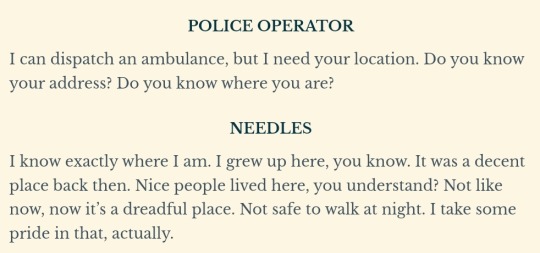
i hope they explain what the fuck needles is on about and dont just graham folger this entire paragraph
like i know we'll get the lore, but also i need to know why on earth was the guy ranting about the residents of that area
cannot stand another 'ate a whole book without any apparent reason'
2K notes
·
View notes
Link
0 notes
Text
Jane’s World
How Jane Austen has remained a phenomenon for more than two centuries.
By Martin Amis December 31, 1995

Photograph from BBC / Album
Currently, it seems, Jane Austen is hotter than Quentin Tarantino. But before we try to establish what the Austen phenomenon is, let us first establish what it is not. About eighteen months ago, I went to see “Four Weddings and a Funeral” at a North London cineplex. Very soon I was filled with a yearning to be doing something else (standing at a bus stop in the rain, for example); and under normal circumstances I would have walked out after ten or fifteen minutes. But these weren’t normal circumstances. Beside me sat Salman Rushdie. For various reasons—various security reasons—we had to stay. Thus the Ayatollah Khomeini had condemned me to sit through “Four Weddings and a Funeral”; and no Iranian torturer could have elicited a greater variety of winces and flinches, of pleadings and whimperings. One was obliged to submit, and absorb a few social lessons, in agonizing surroundings. It felt like a reversal of the Charles Addams cartoon: I sat there, thoroughly aghast, while everyone about me (save the author of “The Satanic Verses”) giggled and gurgled, hugging themselves with the deliciousness of it all. The only good bit was when you realized that the titular funeral was going to feature Simon Callow. I clenched my fist and said yes. At least one of them was going to die.
“Well,” I said, when it was over, “that was bottomlessly horrible. Why is it so popular?”
“Because,” said Salman, “the world has bad taste. Didn’t you know that?”
Still, bad taste doesn’t quite cover it. I can see that the upper classes might enjoy watching the upper classes portrayed with such whimsical fondness. But why should it appeal to four hundred berks from Hendon? In any postwar decade other than the present one, “Four Weddings” would have provoked nothing but incredulous disgust. A sixties audience would have wrecked the cinema. Yet now it seems that the old resentments have evaporated, and “the million,” as Hamlet called them, feel free to root for the congenital millionaires. They can lapse into a forgetful toadyism, and abase themselves before their historical oppressors. Class is harmless, class is cute; class is even felt to be classy. “Four Weddings” is of course deeply “sentimental” in the colloquial sense: it displays false and unworthy tenderness. But it is also sentimental in the literary sense: an exhausted form has been speciously revived. Houses, parties, house parties, amorous vicissitudes in opulent drawing rooms and landscaped gardens, do’s and don’ts, “p”s and “q”s, old money and unlimited leisure. To get in the mood for “Four Weddings,” imagine you are the Reverend Collins on laughing gas. It is Jane Austen, in a vile new outfit.
“Persuasion” has recently been filmed, and so has “Sense and Sensibility,” and there are three versions of “Emma” in the works (not to mention “Clueless”), and no doubt someone will soon knock off the amiably mock-Gothic “Northanger Abbey,” and someone else will find the nerve to tackle the problematic austerities of “Mansfield Park,” and that will be that. For “Pride and Prejudice” has been most comprehensively taken care of, in the BBC’s six-part, nine-and-a-half-million-dollar serial, which has been emptying the streets of England every Sunday night (and which will arrive on American screens on January 15th). Austen fever, or more particularly Darcymania, is upon us. Features editors have been reduced to commissioning interviews with lorry drivers and insulation engineers who happen to be called Darcy; tourist pilgrimages to Jane Austen’s house (in Chawton, Hants) were up about two hundred and fifty per cent in October, and sales of Austen tote bags, Austen crockery, Austen sweatshirts, Austen tea towels, and Austen aprons were comparably brisk; while you’re listening to “The Jane Austen Music Compact Disc” (stuff she might have heard or played), you can rustle something up from “The Jane Austen Cookbook” (all ingredients have been modernized); and so on. Much of this enthusiasm is, of course, collateral enthusiasm, or Heritage enthusiasm: a blend of disembodied snobbery and vague postimperial tristesse. No doubt, too, many of the serial’s ten million viewers watched it in the same spirit as they watched “Four Weddings”—contentedly stupefied by all the eccentricity and luxe. But such wastage is inevitable, and even appropriate. “Sense and Sensibility” and “Persuasion” play at the art houses. “Pride and Prejudice” plays in your living room; and—true to the book—it comes at you with a broad embrace.
Some may be funnier than others, but all Jane Austen’s novels are classical comedies: they are about young couples finding their way toward a festive conclusion, namely marriage. Furthermore, all Jane Austen’s comedies are structurally the same comedy. There is a Heroine, there is a Hero, and there is an Obstacle. The Obstacle is always money (not class—Mrs. Bennet’s origins are in “trade,” but so are Mr. Bingley’s). With the exception of Emma Woodhouse, all the Heroines are penniless and have no dependable prospect other than comfortless spinsterhood. As the Hero heaves into view, he will appear to be dogged by a female Rival—schemer, heiress, or vamp. The Heroine, for her part, will be distracted, tempted, or merely pestered by a counterfeit hero, a Foil—seducer, opportunist, or fop. The Foil can be richer than the Hero (“Persuasion,” “Mansfield Park”) and, on the face of it, much better fun (“Mansfield Park”). The Hero can also be uglier than the Foil. In her adaptation of “Sense and Sensibility” (which has a double Heroine), Emma Thompson does what she can to spruce up Colonel Brandon—the part is given to Alan Rickman—but the novel makes it plain that he is a pitiable old wreck of thirty-five. Brandon represents authorial punishment for Marianne’s unrestrained infatuation with her Foil, John Willoughby (played in the film by the charmlessly handsome Greg Wise). The flaws of the Foil will highlight the Hero’s much solider merits. While the Heroines have foibles, the Heroes are all paragons. Two of them—Henry Tilney and Edmund Bertram—are vicars.
In “Pride and Prejudice,” Austen turned up the dial that controls the temperature of comedy, giving it some of the fever of what we would now call romance. Both Rival and Foil are almost melodramatically garish figures: the self-woundingly feline Caroline Bingley, the debauched and self-pitying George Wickham. They create logistical difficulties, but neither is capable of mounting the slightest threat to the central attraction. For Elizabeth Bennet is the most frictionlessly adorable Heroine in the corpus—by some distance. And, as for the Hero, well, Miss Austen, for once in her short life, held nothing back: tall, dark, handsome, brooding, clever, noble, and uninhibitedly rich. He has a vast estate, a house in town, a “clear” ten thousand per annum. His sister Georgiana has thirty thousand pounds—whereas Elizabeth’s dowry amounts to about a quid a week. No reader can resist the brazen wishfulness of “Pride and Prejudice,” but it is clear from internal evidence alone that Austen never fully forgave herself for it. “Mansfield Park” was her—and our—penance. As her own prospects weakened, dreams of romance paled into the modest hope for respectability. “Persuasion” was her poem to the second chance. And then came death.
This autumn, as the new serial got into its stride, distressed viewers rang up the BBC in tears, pleading for the assurance that fate would smile on the star-crossed pair and all would yet be well. I was not among these callers, but I sympathized. And I quite understood why the “Pride and Prejudice” video, released midway through the run, sold out in two hours. When I was introduced to the novel, at the age of fourteen, I read twenty pages and then besieged my stepmother’s study until she told me what I needed to know. I needed to know that Darcy married Elizabeth. (I needed to know that Bingley married Jane.) I needed this information as badly as I had ever needed anything. “Pride and Prejudice” suckers you. Amazingly—and, I believe, uniquely—it goes on suckering you. Even now, as I open the book, I feel the same panic of unsatisfied expectation, despite five or six rereadings. How can this be, when the genre itself guarantees consummation? The simple answer is that the lovers really are made for each other—by their creator. They are constructed for each other: interlocked for wedlock.
Andrew Davies, who adapted the novel for television, was shrewd enough to regard his function as one of artistic midwifery—to get the thing out of the page and onto the screen in as undamaged a state as possible. After all, he had before him the example of the Olivier-Garson version of 1940 (based on a script by Aldous Huxley, among others): cold proof that any tampering will reduce the original to emollient inconsequentiality. Huxley’s reading is disastrously winsome; even Lady Catherine de Bourgh is a good egg. Still, the adapter has to do what the adapter has to do. The pious and vigilant Janeite looks on, ever ready to be scandalized by the merest breach of decorum.
Very early on, we see Elizabeth in the bedroom she shares with Jane, saying, “If I could love a man who would love me enough to take me for a mere fifty pounds a year, I should be very well pleased.” This puts us in the financial picture (and we will soon be seeing Mr. Bennet sighing over his account book); but it commits Elizabeth to a predisposed mooniness quite at odds with her defiant stoicism. Later, when the scandal of Lydia’s elopement breaks, and Darcy gauntly takes his leave of Elizabeth in the inn near Pemberley, Austen writes, “Elizabeth felt how improbable it was that they should ever see each other again on such terms of cordiality as had marked their several meetings in Derbyshire.” This translates as a one-line soliloquy: “I shall never see him again.” Austen’s lines show a brave face in adversity, Davies’ an admission of a love Elizabeth does not yet feel. Each shifted brick threatens the whole building.
TV is TV, and TV Man wants visual equivalents for every “it” and “the.” And the visual is always literal, funnily enough. Any protracted passage of background explication is accorded a lavish collage. Darcy’s letter to Elizabeth, with its revelations about Wickham’s character, inspires a scene set in Cambridge: Darcy in his gown and mortarboard, striding through a colonnade, mounting the stairs—and surprising the smirking Wickham with a half-clad scullery maid on his lap. We see Lydia and Wickham’s midnight flit (la, how they cuddle in the carriage!), we see Darcy pacing the festering streets of London in search of them, and we see the runaways in their bedroom at the rude tavern. Elizabeth and Darcy don’t just think about each other, they have hallucinations about each other. They’ve got it that bad.
Davies’ more minor interpolations are usually pretty deft and sometimes downright felicitous. But every Janeite is like the Princess and the Pea. Wickham doesn’t say that Darcy “refused point blank” (though he might have done—the epithet is sufficiently elderly). Elizabeth would never say (skeptically), “Astonish me!” Even Lydia would not wonderingly repeat the (invented) line, “A whole campful of soldiers. . . .” Nor would she say, “We shall have some laughs.” When Elizabeth refuses Darcy’s first offer of marriage, he notes that she spurns him “with so little effort at civility,” whereas the book has the clearly superior “so little endeavour at civility.” A few pages earlier, a nifty subjunctive is lost when “I expected at least that the pigs were got into the garden” becomes “the pigs had got into the garden.” I could go on. But by now I feel I am trespassing on the reader’s patience. Then again, I would argue that these tiny precisions, these niceties, are the atoms that constitute Jane Austen’s universe. And after a long immersion in her work, I find that her thought rhythms entirely invade my own. Normal social intercourse becomes increasingly strained. People look at me oddly. If, for example, the editor had called, to inquire after the progress of the present piece, I would have been like to reply, “Nay, Madam, I find I get on excessively ill. I need more time alone with Jane. May I extort, then, the indulgence of a further se’nnight?”
In David Lodge’s novel “Changing Places,” a tweedy little British academic goes to teach at Euphoric State University, on the West Coast, while a big brash American academic goes to teach at a rain-sodden redbrick called Rummidge. The American, Morris Zapp, wearily begins his seminar:
“What are you bursting to discuss this morning?” “Jane Austen,” mumbled the boy with the beard. . . . “Oh yeah. What was the topic?” “I’ve done it on Jane Austen’s moral awareness.” “That doesn’t sound like my style.” “I couldn’t understand the title you gave me, Professor Zapp.” “Eros and Agape in the later novels, wasn’t it? What was the problem?” The student hung his head.
The immediate joke here is the contrast in critical styles: the British still locked in the ethical battlefields patrolled by F. R. Leavis, the Americans soaring off into the architectonics of myth and structure. But Lodge’s deeper point is that Jane Austen is weirdly capable of keeping everybody busy. The moralists, the Eros-and-Agape people, the Marxists, the Freudians, the Jungians, the semioticians, the deconstructors—all find an adventure playground in six samey novels about middle-class provincials. And for every generation of critics, and readers, her fiction effortlessly renews itself.
Each age will bring its peculiar emphasis, and in the current Austen festival our own anxieties stand fully revealed. We like to wallow in the accents and accoutrements of Jane’s world, but our response is predominantly sombre. We notice, above all, the constriction of female opportunity: how brief was their nubility, and yet how slowly and deadeningly time passed within it. We notice how plentiful were the occasions for inflicting social pain, and how interested the powerful were in this infliction. We see how little the powerless had to use against those who might hate them. We wonder who on earth will marry the poor girls. Poor men can’t. And rich men can’t. So who can? We fret and writhe at the physical confinement (how desperate these filmmakers are to get their characters out-of-doors). Of all virtues Jane Austen valued “candour”; but candor, as we understand it, has no arena in which to exercise itself. One honest exchange between Anne Elliot and Frederick Wentworth and “Persuasion” disappears. We long to give them our pleasures. We wonder at their self-repression. And we are terrified by their circumambient boredom.
The BBC’s new serial has been touted in the press as revealing the latent “sensuality” of Jane Austen’s imagination; naturally it reveals much more about the blatant sensuality of our own. Austen, after all, is notoriously cerebral—a resolute niggard in her descriptive dealings with food, clothes, animals, children, weather, and landscape. But we in the nineties will not have it so. Thus at the outset, on our televisions, Darcy and Bingley thunder toward Netherfield Park on their snorting horses, while Elizabeth enjoys a hearty tramp on a nearby hillside. Later, climbing from the bath, Darcy looks out of the window and sees Elizabeth romping with a dog. Lydia is surprised half-clad by Mr. Collins—and gigglingly confronts him with her cleavage. In the throes of his imprudent passion for Elizabeth, Darcy takes up fencing. “I shall conquer this,” he mutters. “I shall.” Returning to Pemberley, unshaven, with the hot horse between his thighs, he dismounts and impetuously plunges into a pond. Here, clearly, we are moving away from Jane Austen, toward D. H. Lawrence—and Ken Russell. “There is a lot of pent-up sexuality in Austen’s work,” Davies has said, “and I have let it out.” But why stop there? Why not give her some Vitamin C and a backrub? Austen’s characters resist the ministrations of the therapy age. As literary creations, they thrive on their inhibition. It is the source of all their thwarted energy.
Now for the performances, which are a testimony to phenomenal strength in depth and to the accuracy and inconspicuousness of Simon Langton’s direction. Jennifer Ehle (pronounced “Ely”) is not quite the perfect Elizabeth, for such a creature could not exist in nature; Elizabeth, simply, is Jane Austen with looks, and such a creature could never have created Elizabeth. Ehle has the spirit and the warmth; she has a smile of almost orgasmic sweetness; she contrives to look voluptuous and vulnerable in the egg-cozy maternity outfits that “authenticity” has clothed her in; and she has the eyes; but she cannot quite inhabit the surrogate intelligence. Colin Firth is an insidiously persuasive Darcy, as he makes his journey from probity to right feeling. To know her heart, all Elizabeth needs is the facts before her. Darcy has to complete two centuries of evolution. The ensemble players are led by Alison Steadman. Some dull dogs have found her Mrs. Bennet too broad, too Dickensian, but in fact she establishes a miraculous equipoise between bitterness and boiling vulgarity (and this balance is sustained by the memory of her physical allure). Susannah Harker makes a languid, comfortably ponderous Jane; Julia Sawalha gives us Lydia’s “high animal spirits”; David Bamber is a marvellously contorted and masochistic Mr. Collins; and Anna Chancellor locates an unexpected pathos behind Caroline Bingley’s expert barbs. The one important failure is Mr. Bennet. Benjamin Whitrow’s line readings are thoughtful and confident, but he is too quick to take refuge in wryness and twinkle. The most cynical character in all Jane Austen, Mr. Bennet is the dark backing behind the bright mirror. He, too, is very close to his creator, and Jane Austen feared his weakness in herself. Mr. Bennet makes sport with his own despair.
The sensualism imported by Davies and Langton brings one unarguable gain: all those creamy, dreamy scenes in the bedroom shared by Elizabeth and Jane, with the candles lit and the hair down, make us feel the crucial heaviness of their sisterly love. We are reminded that the emotional argument of the book is intimately bound up with this relationship; and we feel its weight without realizing why it weighs so much. Watching Marianne’s near-death scene (lovesickness, fever) in “Sense and Sensibility,” I wondered why I was so pierced, and so desolated, when Elinor addresses her sister as, simply, “my dearest.” We are moved because the endearment is literally true—and may well remain true, for life. For the unmarried, no reconfiguration awaits the pattern of their love; their nearest are their dearest, and that is the end of it. In “Persuasion,” we sense Anne Elliot’s further privation as she probes for warmth in the humorless solipsism of her sister Mary. And we naïvely console ourselves that Jane Austen, whatever else she lacked, at least had Cassandra.
“Four Weddings and a Funeral” had something to be said for it; as a result of one typically embarrassing scene, an opportunist edition of ten Auden poems climbed into the best-seller lists. This book was called “Tell Me the Truth About Love” and had a photograph of Hugh Grant on its cover (and Grant, incidentally, makes a creditable Edward Ferrars in “Sense and Sensibility”). On Jane Austen, Auden was great but wrong:
You could not shock her more than she shocks me; Beside her Joyce seems innocent as grass. It makes me most uncomfortable to see An English spinster of the middle-class Describe the amorous effects of “brass,” Reveal so frankly and with such sobriety The economic basis of society.
We of the nineties would most certainly shock Jane Austen, with our vast array of slovenly and unexamined freedoms. Nonetheless, there is a suspicion of cant in Auden’s lines. “Brass” made Charlotte Lucas accept Mr. Collins (“disgracing herself” with a prudential marriage), but it didn’t make her love him. Elizabeth turned down Mr. Collins; and, with so little endeavor at civility, she turned down Mr. Darcy, too, with his ten thousand a year. Writing about Gray’s “Elegy,” William Empson said that the poem presents the condition of provincial oblivion as pathetic without putting you in a mood in which you would want to change it. But “change” is the business of satire. Satire is militant irony. Irony is more long-suffering. It doesn’t incite you to transform society; it strengthens you to tolerate it. Jane Austen was indeed an English spinster of the middle class. She died in unrelieved pain at the age of forty-one. On the other hand, she has now survived for nearly two hundred years. Her lovers are platonic lovers, but they form a multitude. ♦
Published in the print edition of the January 8, 1996, issue, with the headline “Jane’s World.”
0 notes
Text
Minicabs in Hendon London
Looking for affordable minicabs in Hendon London? New Century Cars Hendon Minicabs offers local and Hendon airport taxi transfer services at affordable rates and no hidden charges. Clean cars, licensed and professional drivers.

#hendon London#Hendon UK#Minicabs in Hendon#Taxi in Hendon#Cab in Hendon#Hendon Airport Taxi Transfer#Hendon Airport Shuttle Service#Hendon Executive Car Service#Hendon Tumblr#Tumblr Uk#trendin#tumblr trending#tumblr news#news#marketing
0 notes
Text

Disobedience - Naomi Alderman
Can an Orthodox Jew be a lesbian? Two women, one a rabbi’s daughter, find different solutions to the problem.
Hendon, the setting for British Alderman’s debut—and Orange Prize finalist—is a London suburb with a large Orthodox Jewish community. Its rabbi, the scholarly, charismatic Krushka, is dying. He is being cared for by his nephew Dovid, also a rabbi, and the man already chosen to succeed Krushka by synagogue board president Hartog, who sees Dovid as submissive and malleable. The fly in the ointment is Dovid’s wife, Esti, a woman quiet to the point of eccentricity. The other female troublemaker is Krushka’s 32-year-old estranged daughter, Ronit, who’s been living in New York since her father sent her there to complete her schooling. The flamboyant Ronit’s brief return from New York provides the match for the tinderbox. Ronit and Esti were not just schoolgirls together; they were lovers. Each woman is still attracted primarily to her own gender, though Ronit has been having an affair with her New York boss, a married man. She has renounced the Orthodox world and its stifling expectations of conformity (“Orthodox Jew Barbie: comes complete with Orthodox Ken”), while Esti has remained true to her religion, though she is eager to resume her relationship with Ronit. What follows is a complicated dance involving the two women and the gentle, good-humored Dovid. Each chapter begins with a page of lucid commentary on the scriptures, which put the protagonists’ floundering in a religious context. However, their Olympian tone is an intrusive feature in a novelistic landscape of satire and character development. Thus, although there are effective scenes (the attempt by the villainous Hartog to bribe Ronit to stay away from the hesped, or memorial service, and Esti’s uncharacteristic “outing” of herself at the service), they don’t combine to form a satisfying narrative flow. A mishmash, but not without promise.
0 notes
Link
Check out this listing I just added to my Poshmark closet: Ted Baker Hoodie Mens 3 Medium Blue Pullover Hendon Fleece Sweatshirt London.
0 notes
Photo

Woman found with £2bn in Bitcoin convicted A former takeaway worker found with Bitcoin worth more than £2bn has been convicted at Southwark Crown Court of a crime linked to money laundering. Jian Wen, 42, from Hendon in north London, was inv…
0 notes
Text
ONCE IN 79’: Sham 69' Dave Parsons and Jimmy Pursey, Middlesex Polytechnic, Hendon, London, 26th January 1979
ONCE IN 79’: Sham 69′ Dave Parsons and Jimmy Pursey, Middlesex Polytechnic, Hendon, London, 26th January 1979 Photo by © Rob Hall. (Photo from 3rd February ’79 – “New Musical Express”, UK) “January 26, 1979 SHAM 69 are shaken tonight by more violence at a hometown gig in Hendon, North London. The group had been plagued with trouble at their shows since right wing factions have labeled the…

View On WordPress
0 notes
Text




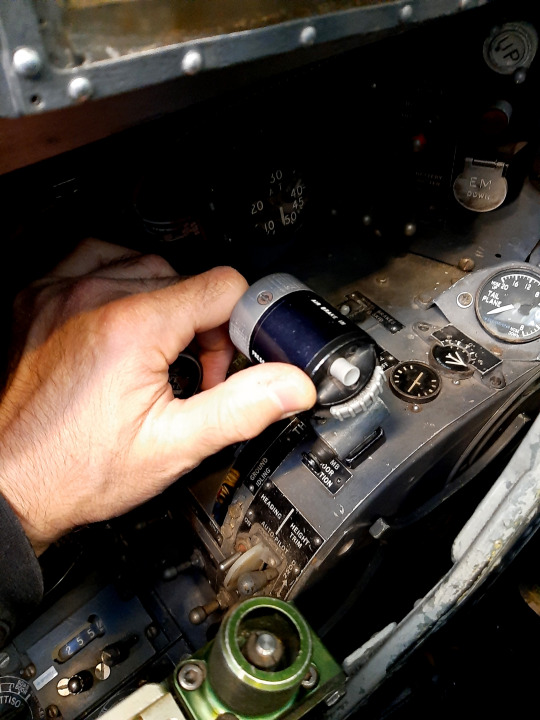























"Access the Buccaneer" _ RAF Museum London, Grahame Park Way, London, NW9 5LL _ Photos by Spyros Kaprinis [28.10.2023].
"The only Buccaneer in preservation to retain its original ARTF (desert pink) paint, located at the RAF Museum London, more commonly known as Hendon.
XW547 was delivered to the RAF on 31st October 1972 with 15 Squadron RAFG at Laarbruch two days later. She went on to serve with 12 Squadron, 237 OCU, 216 Squadron, then received new wings in late 1980 (a result of inspections after the Red Flag Buccaneer crash that was caused by spar fatigue) and then onward to 208 Squadron and 12 once more. She took part in 1983's 'Operation Western Fox' - slamming Martel missiles into old ships in Florida - and by 1986 was Sea Eagle-capable.
In January 1991 XW547 was prepared for the Gulf War with a few modifications, repainted in the Alkali Removeable Temporary Finish (ARTF), better known as 'desert pink'. She was given the tail code 'R', named The Macallan, and received the nose art 'Guinness Girl/Pauline'. During the Gulf, XW547 took part in 11 missions, after each mission a bomb marking (mission symbol) was added underneath the cockpit on the starboard side that can still be seen on her today. XW547 retired later that year, going into storage a Shawbury before being used as an instructional airframe."
0 notes
Text
Top London Areas for Property Investment: Insights from Joe Ricotta
Joe Ricotta, a real estate developer, has provided his insights on the best places in London for property investment. Here are three areas that he recommends:
Hendon, North-West London: Hendon is a vibrant residential area in North London that offers numerous investment opportunities and attractions. It is home to Brent Cross, one of London's largest shopping malls, and the Brent Reservoir, also known as the Welsh Harp, which features 170 hectares of marshland and water. Hendon boasts a diverse range of architectural styles, including modern detached residences on prestigious streets like Brampton Grove. Families can enjoy excellent schools, parks, restaurants, and efficient infrastructure that provides quick access to the rest of London.
Wembley, North-West London: Wembley is known for hosting the England national football team and Wembley Stadium. It is continuously being renovated and has transformed into a bustling neighborhood with various retail outlets. Wembley offers a posh retail mall, theaters, restaurants offering diverse cuisines, entertainment options, and ample green spaces. Equipped with three stations and three underground lines, it is roughly 12 minutes away from Central London. Young professionals are particularly drawn to the area due to its attractions, according to Joe Ricotta.
Woolwich, South-East London: Woolwich is an emerging area located five miles downstream from Canary Wharf. It offers a viable alternative for homeowners, with the multibillion-pound regeneration of the Woolwich Arsenal by Berkeley Homes. This regeneration includes 5,000 new homes, bars, restaurants, and a revitalized waterfront. Additionally, the upcoming Crossrail project is set to improve transportation links in 2021. CBRE predicts that Woolwich will have the highest "regeneration home price growth premium" in London, at 7.6% each year. With its river, green spaces like Oxleas Wood and Plumstead Common, Woolwich is an attractive site for real estate investment.
These three areas provide potential homeowners with a range of benefits, including regeneration projects, transportation links, amenities, and opportunities for price growth. However, it is important to thoroughly research and consult with experts before making any property investment decisions.
1 note
·
View note